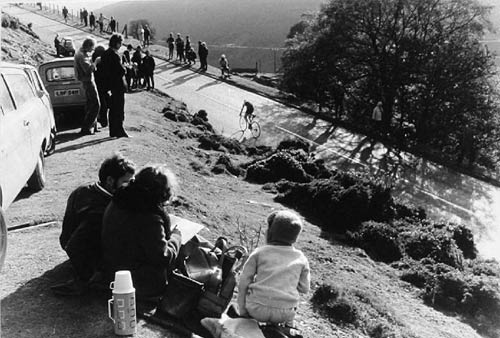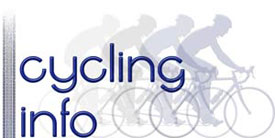
It’s the time of the year, when 100 mile time trials are distant memories. It’s no longer about endurance, stamina, but about pure speed, strength and your power to weight ratio.
The hill climb is very much a specialist event, unlikely to appeal to all cyclists – (especially those with more than adequate layers of insulation.)
But, for those who ride hill climbs, it can be an interesting experience. There is a certain art to riding hill climbs and it is important to practise before racing. When you are riding so close to the limit, pacing becomes very important and can make a big difference to the final time.
A comparable event to hill climbs is the 4km pursuit. The 4KM pursuit takes around 4 minutes, similar to many hill climbs. Though the gradient and speed are very different, it is effectively a similar effort and pacing level.
Length of Climb
When preparing for a hill climb, the first thing I want to know is – how much time is it likely to take? For example – if it is a one mile climb, average gradient 10% – it is likely to be around four minutes. If it is 1km at around 15% it would be perhaps 3 minutes. You can get a good idea by looking at previous hill climb results and looking at the times of similar riders. From the time taken you can start thinking about the type of pacing you need for the hill climb.
There are definitely different types of Hill Climbs
Short Explosive Climb
These climbs are less than a mile Perhaps 0.8 to 1.0Km. (around 1000 yards). They also tend to be steep. For example, the Cat and Bec Hill climbs are both around 1Km and average 15-20%, with sections of 25%.
The winner will be just under two minutes. Therefore, it is a short explosive climb, almost like a sprint. It tends to favour short, powerfully built riders. Winning margins can be matters of fractions of a second, so every pedal and effort counts.
To ride this kind of climb
- Start fast, just below the effort of an all out sprint.
- All the time, you are trying to increase the effort, so that for the last minute it is a matter of hanging on. In the last minute, you should be riding at your maximum heart rate (or as near as you can get to it). You are likely to feel a little dizzy in the head, because all the blood is in the legs.
Even on a two minute climb, it is dangerous to blow up after the first minute. You have to save that for last minute of climb, where at the end you will hopefully fall over into the arms of the catchers absolutely exhausted from the all out effort.

Bank Road Hill Climb, Matlock, 2008 National Championships.
Two to Three Minute Hills
The National hill climb championships on Bank Road, Matlock and The Rake, Ramsbottom, are in many ways the classic hill climb. Going through the centre of a town, they are both remorselessly steep and will take the winner around 2.30 or 2.40. At the steepest the Rake is 25%, and Bank Road is around 20%.
With a crowd at the bottom, there is a danger of getting overexcited and sprinting full out from the bottom, but, this can lead to grovelling up last half of climb. But, you can’t afford to hold too much back, you need a certain momentum and keep this as much as possible right to the top.
See also: Pacing steep hill climbs
One Mile – Four Minute climbs

Jim Henderson, former OUCC team mate and multiple Hill climb champion in 2007 National Hill Climb Championship in Devon.
Many hill climbs, such as the 2010 National Hill climb championship on Dover’s Hill, in the Cotswolds are around four minutes. I tend to roughly break these up into one minute sections. Each minute, you try to increase the intensity. The first minute is fast but each minute, you go a little harder and harder. The trick is knowing that fine line of effort you can maintain in the first half. It is a level fast so your legs will be burning, but, enabling you to slightly increase the effort over the last half of the climb.
Long Climbs, Seven Minutes Plus
My favourite hill climbs are those of two miles are longer. They require even more careful pacing to get the best from the climb. Two examples are Cheddar Gorge, Somerset and Jubilee Tower, Lancashire. Both climbs start with a very steep, difficult section, and then flatten out for a long gradual ascent to the summit. Here the trick is to get over this fast section, leaving enough in tank to really fly up the remaining gradual gradient.
The easiest mistake is to blow up the first two minute steep section. Meaning you can only slowly climb up the fast section. It can feel really demoralising to be going slowly on a section which is barely going up hill.
On the Jubilee hill climb 2009, where I set a course record of 7.13, there is a very slight downhill finish. I finished in a 53*12 at 32 mph. You can pick up so much time on this section – if you have enough left to make the most of these gentle gradients. I could easily have gone 10 seconds quicker on the steepest section at the bottom, but, I would definitely have lost over 10 seconds on the gentle upper slopes.
The Alpine Pass
These are climbs of 10Km are more. They tend to be of a more gentle and constant gradient. Here it is about getting into a good rhythm. A rhythm where you will spend most of the time in the saddle, and try to power your way up. It is more like doing a ten mile time trial, as the effort can last for 20-40 minutes. In the UK, we don’t have many climbs like this. But, there are a few like the Cat and Fiddle and Shap Hill climb in the Lake District. These climbs may appeal to the non hill climbing specialist as they are not so violent in their gradient and effort required.
In Hill Climbs There are two things you need to master.
- Knowing the effort level which you can maintain in first half without blowing.
- The ability to ride at your absolute maximum for the second half.
Riding at Your Maximum
When you’re on the last half of a climb, you need to be pushing the body to the limit. Your body will be sending you every signal to slow down (burning leg, pain in chest, difficulty breathing, light headedness). You need to be able to ignore these and keep going.
Practise will help give you an idea of what you can do. But, this all out effort is only likely to come in an actual race.
You also need the mental concentration, and focus and desire to race at that level. You need to be in a very good mental space to be able to ride at this intensity. You have to be clear how hard you are going to be going and determined to maintain it. If there is any doubt or feelings of tiredness, you will hold yourself back and not be able to maintain yourself in that red zone.
Top Tips for Riding Hill Climbs
- Know how long it is likely to take. If I know how long it is likely to take, I don’t really need to even pre-ride the climb, though it is better if you can.
- Ignore the Gradient. Ride to your optimal effort level, don’t ride at a pre-determined speed. The biggest mistake is to kill yourself up a steep bottom section, meaning you are in the red for rest of climb and lose time on last half.
- Prevent Wheel Spin. On really steep climbs your back wheel can slip in the wet. It may be necessary to reduce tyre pressure in the rear.
- You want to ignore the gradient and ride to optimal power / effort. This means for flatter sections, you can potentially go much faster.
- The best training is often just riding up hills. Get to know what your body can take.
- Be really determined to push your body into its limits on last half.
- It is helpful to know the climb, riding before hand
- Don’t eat a Big Mac and fries twenty minutes before starting
Fixed vs Gears
Chris Boardman said unless the climb goes downhill, you will be quicker on fixed. But, I prefer using gears. The weight saving is not absolutely critical, it may amount to about 2 seconds for a shortish hill. (see: importance of weight on bike) If you do go fixed, you have to get the gear right. Bear in mind a headwind or tailwind can make a huge difference, if the wind is swirling you could find yourself with wrong choice.
In Saddle vs Out of Saddle
There is much debate about best way to climb – do you try and ride in saddle or get out and use whole body, standing up on pedals.
Generally, I try and ride seated in the saddle. This position is more aerodynamic and more efficient, so as much as possible I try to stay in this position. However when the gradient gets too steep, then you need more power and so I get out of the saddle. For long gradual climbs, I am mostly staying in the saddle, apart from perhaps the odd moment to get out of saddle to give body a different position.
For difficult climbs with tough gradients, you will be almost forced to get out of the saddle.
I haven’t worked out a scientific method of when to be in saddle and when not. It just seems an instinctive thing about climbing.
Tri Bars – Time Trial Bike
There are some hill climbs with a gradual gradient, where you may go quicker by using tribars. On climbs of 5% or less, you might be averaging over 20mph, so the aerodynamics play an increasing role. The weight of some clip on bars may only be 200-300 grams and so the aerodynamics outweigh weight gain. Make sure, the use of tribars is not restricting the freedom of your breathing.
Clear Mind
A hill climb is the only race, where I may feel some pre-race nerves, everything happens so quickly, you need to maximise every pedal stroke and effort. It also requires a big mental effort to ride at your highest intensity. Keep your mind clear of distracting thoughts – try to feel every pedal stroke and feel you are accelerating up the climb. Have a clear idea of where finish is, and make sure you don’t find any excuse to hold back before the top.
Related

Yes, definitely you need a good warm up, especially for any of the explosive climbs.
> A 17 second hill climb hmm! well I guess you get it over with quick!
Takes me longer than 17 seconds to swing my leg over my bike!!
A bit short notice but there is a hc on in Malvern tomorrow (sunday 29th) It’s really short, record stands at 17 seconds! It’s on Church Street , entry on the line from 11.30 am
I’m guessing you need to do some kind of warp-up (or at least some stretching) before undertaking upon such an intense burst of effort?